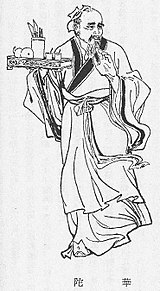Wu Qin Xi
Wu Qin Xi (五 禽 戲), also Wǔqínxì ("the art of the five animals" or "the game of the five animals"), is a gymnastic movement system developed by the Chinese doctor Hua Tuo in the 2nd century ( Eastern Han Dynasty ). Like Ba Duan Jin ("Eight Brocades") or Yì Jīn Jīng ("Book of Light Muscles"), it is one of the ancient forms of Qigong and has been tested and standardized by experts from the Beijing Sports University (CHQA). At that time, Hua Tuo passed the Wu Qin Xi on to his student Wu Pu, which had lasted for generations within his family.
When developing the Wu Qin Xi, Hua Tuo oriented himself on the "oldest imitations of animals that represent the original human powers: the bear (symbolic for earthly connection), the bird (for lightness), the tiger (for power) and the snake (for suppleness) ”.
Hua Tuo's exercise concept imitates the tiger (虎 hǔ), the monkey (猴 hóu), the deer (鹿 lù), the bear (熊 xióng) and the crane (鹤 hè) and thus differs from Wu Xing Xi , who five animal systems of Shaolin “, which includes the forms of the tiger, the dragon (龙 lóng), the leopard (豹 bào), the snake (蛇 shé) and the crane. The game of the five animals is considered to be the origin of Wu Xing Xi.
The individual animal styles in Wu Qin Xi are not carried out as purely physical exercises, but the goal is to understand the animal and its nature itself and to express this in the movements.
The exercises of the game of the five animals also support the function of the functional circuits , five of which the Yin and five the Yang are assigned. The tiger is assigned to the lungs, the monkey to the stomach, the deer to the liver, the bear to the kidneys and the crane to the heart. Wu Qin Xi is important in Traditional Chinese Medicine (TCM) as it increases general well-being, prevents disease and promotes health. Today it is used, among other things, in cancer therapy.
literature
- Werner Lind : The dictionary of martial arts. Edition BSK, Sportverlag, Berlin 2001, ISBN 3-328-00898-5 , p. 658
- Ute Engelhardt, Gisela Hildenbrand, Christa Zumfelde-Hüneburg (eds.): Guide to Qigong. Munich: Urban & Fischer in Elsevier; 2007, ISBN 978-3437563409 .
Web links
- Medical Qigong Education Center (English)
- China.org.cn: Wu Qin Xi (2) (English)
Individual evidence
- ↑ Werner Lind in: Lexicon of Martial Arts. , P. 658
- ↑ Werner Lind: Lexicon of Martial Arts. , P. 658
- ^ Medical Qigong Education Center
- ↑ China.org.cn: Wu Qin Xi (2)
- ↑ Werner Lind: Lexicon of Martial Arts. , P. 658
